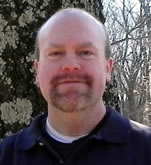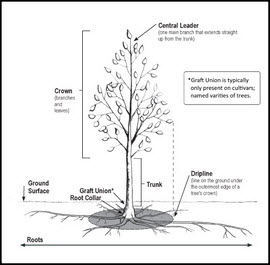
How a tree is planted will have a profound effect on the health and longevity of that tree. There are many good sources of tree planting information online. Websites maintained by State Universities; Federal, State, and local governments; and arboricultural societies are generally good places to search for accurate information on the topic. Yet with all this information readily available I continue to see tree after tree dying due to improper planting techniques.
Whether the companies planting these trees are planting them incorrectly out of ignorance or in pursuit of maximizing profits; get in, get out, get to the next job, I do not know. In either case, it behooves a homeowner or property manager to do their due diligence and educate themselves on proper tree planting technique so that they will recognize when they are receiving a quality service and when they are throwing their money down the drain.
The Seven Deadly Sins of Tree Planting
- Planting the tree too deep
- Failure to a dig a planting hole of appropriate width
- Failure to remove twine and burlap from the root ball
- Failure to remove wire cage from the root ball
- Burying the tree trunk under a "mulch volcano"
- Overuse of just a small number of tree species
- Planting the tree too deep
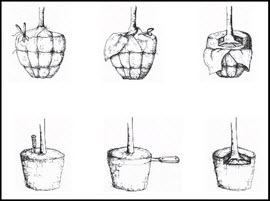
1) Planting the Tree too Deep
The first item shows up twice to make a point. In my experience the number one cause of tree decline and death, by a wide margin, is setting trees too deep in the soil. I estimate that out of every 10 trees, less than 10-15 years old, that I am called on to diagnose a health problem, 8 or 9 of those trees are suffering from issues directly related to incorrect planting depth.
To plant a tree at the correct depth it is necessary to understand the concept of the "root collar." The root collar is the transition zone between the lower trunk and the roots. The tree should always be planted so that the root collar is at, or slightly above, the surrounding grade. If you were to envision the tree as an old-fashioned wooden wagon wheel, with the hub representing the tree trunk in cross-section and the spokes representing the first major roots, the very tops of those spokes (roots) should be visible where they join with the hub (trunk) after planting.
More often than not when a tree is received from a nursery balled in burlap (B&B) there will be some excess soil between the root collar and the top of the root ball. Therefore before any shovel breaks the ground, the top of the root ball must be untied and the burlap pulled back to expose the soil. Then the excess soil can be carefully shaved off the top of the root ball until the root collar and tops of the first major roots are exposed. Go slowly, shaving off a little at a time, and take care to avoid damaging the thin bark of the root collar. Measuring from the root collar down to the bottom of the root ball will then determine how deep you must dig your planting hole. I like to subtract an inch from whatever figure I get just to be certain that after the tree is set in the ground the root collar will be at, or slightly above grade.
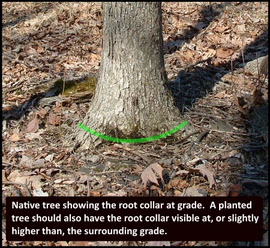
2) Failure to Dig a Planting Hole of Appropriate Width
We are often planting trees on sites where the native soil has been heavily disturbed. When a site is developed the topsoil is typically removed because, although it has great characteristics for root growth, it makes a poor structural foundation for building on. When construction is complete some topsoil is brought back in since the subsoil that served as a sound foundation for building on is typically too compacted to support healthy root growth. There may now be just a few inches of topsoil sitting on top of that dense subsoil; enough to allow grass to grow. In short, if you are planting on a site that has only recently been developed, you are probably planting in soil that lacks the physical characteristics required for good root growth.
The way we compensate for this situation is to dig our planting pit as wide as possible and loosen up a large volume of that dense soil so that tree roots can penetrate into it. A good rule of thumb is to make the planting pit 3 times the width of the root ball. I also strongly recommend mixing a large amount of organic material into the soil excavated from the planting pit prior to backfilling around the root ball. Amending the backfill 30% by volume with composted organic matter will dramatically improve the ability of the soil to support healthy root growth. Moisture holding capacity, resistance to compaction, biological activity, and nutrient levels will all be improved by adding this organic matter. Leaf compost and composted manure, often mixed with humus, are two excellent sources of organic material.
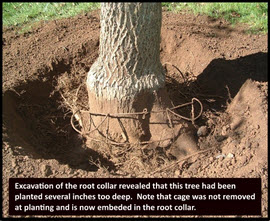
3) Failure to Remove Twine and Burlap from the Root Ball
To start with, if the twine and burlap are not pulled back prior to planting, and the excess soil shaved off of the top of the root ball to expose the root collar, you can pretty much guarantee that the tree is going to be set too deep in the ground. Removing the twine, particularly if it is synthetic twine, is a no-brainer. As the tree grows the trunk is going to increase in diameter and the twine is not. The result is predictable; strangulation of the trunk aka girdling. Failure to remove the burlap causes two problems. First, if some portion of the burlap remains above ground it will act like a wick, pulling moisture out of the ball and exposing it to the air where it rapidly evaporates, causing additional moisture to continuously be pulled out of the ball. Second, it is critical that the soil of the root ball be in direct contact with the backfilled soil so that the tree roots can grow through the interface. If the burlap is left on the ball, it prevents soil to soil contact between the ball and the backfill and thus hinders root growth out into the planting pit.
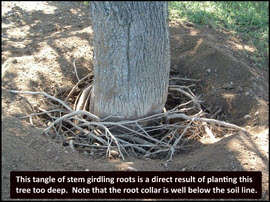
4) Failure to Remove Wire Cage from the Root Ball
When the wire cage is not removed at the time of planting it will eventually become embedded in the roots and root collar. Although the root tissue appears to be able to grow over and around this wire, I suspect that there is some disruption to vascular function as this occurs. I also suspect that as the tree and roots flex in the wind any embedded wire may create small fractures in the root epidermis and cortex that could serve as entry points for decay fungi and other pathogens. Contrary to what I have heard some landscapers suggest, the wire will not rust away to nothing before this embedding occurs; it is after all galvanized wire. I have performed many root collar excavations and have observed that often the cage has degraded very little even several years or more after planting.
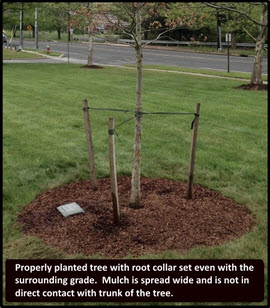
5) Burying the Tree Trunk Under a "Mulch Volcano"
When done properly, mulching the area around a tree provides numerous health benefits. It helps to retain soil moisture, reduces soil temperature, releases nutrients and adds organic matter to the soil as it breaks down, helps avoid lawnmower and weed trimmer damage, and gives the tree a rooting volume where it does not have to compete with grass roots for water, nutrients, and space. The mulch should be no more than 3-4" deep, extend outward as far as possible, and should never be in direct contact with the tree trunk. The mulch volcanoes that can be seen virtually anywhere you look break all of these basic rules. Why has this abominable practice become so ubiquitous? Mulch volcanoes kill trees, period, full stop, it is that simple. It doesn't happen overnight; it may take years for the damage to become obvious, but under this heap of mulch roots are oxygen starved and often growing in such a way as to eventually girdle the trunk and kill the tree. So, knock it off!
6) Overuse of Just a Small Number of Tree Species
The novelist and poet George Santayana said "Those who cannot remember the past are condemned to repeat it." Within just the last 100 years or so we have seen several important tree species decimated from a single newly introduced disease or insect pest: American chestnut (chestnut blight), American elm (Dutch elm disease), ash (emerald ash borer), hemlock (wooly adelgid). Currently, 308 square miles are under quarantine for Asian Longhorn Beetle in the States of New York, Massachusetts, and Ohio. If this insect breaks out of these quarantined areas it could destroy most of the maple trees in the Northeast.
What all these trees have in common is that, in addition to being an important component of our native forests, they were also planted as landscape or street trees in vast numbers. They were overplanted at the expense of diversifying our home and city landscapes. When their various nemeses attacked, whole tree lined streets went bare. It is impossible to predict which species of tree might be the next to be eliminated from our landscapes and the only way to mitigate the risk of losing many trees at once, due to some future pest or disease, is to diversify the species that we plant today. There are more than 500 species of trees that can be grown in New Jersey and some of those species have dozens of cultivated varieties. With all those hundreds of possibilities I see an awful lot of red maples out there.
So let's learn from the past and diversify our planting list. A wonderfully simple way to do this is to use the "10-20-30" rule; for any particular area, the trees planted should consist of no more than 10% of a single species, 20% of a single genus, and 30% of a single botanical family.
7) Planting the Tree too Deep
See number one.


